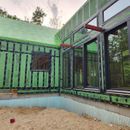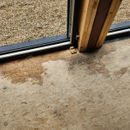zip taping details leading to water intrusion?
Hi all,
Were at the “dried in” phase of our project (CZ 6, NH), and getting ready for insulation (CCSF roof and DP FG walls). Still waiting for the standing seam roof and siding to be installed.
Have zip roof sheathing and zip R9 wall sheathing, all taped. Roof has Protecto-wrap HT underlayment over top as well.
I have a few installation details I’m concerned with at this stage, and I’m worried about adding insulation. There is apparent water getting into the assembly in various locations, so much so that the subfloor and some bottom plates and lower studs appear saturated (it seems to dry out between storms). There are fish mouths in the zip tape installation that are gathering water (I can press on some taped areas and water shoots out). Also, one side of the roof has Protecto-wrap installed horizontally (shingled), and the other side has it installed vertically, overlapped. Why would anyone do that?
How concerned should I be at this stage? The steel roof and siding will obviously be the main layer of defense again the weather, but how “resistant” should the WRB actually be? Add the complication of the “zero overhang” design of the roof to siding detail, and water becomes a real problem. Should I make them re-tape and re-roll everything (again)? Should they add a separate WRB on top?
Thanks,
GBA Detail Library
A collection of one thousand construction details organized by climate and house part











Replies
I'll ask the normal questions:
Are these fishmouths caused by slack/wrinkles in the tape, or are they slumped sections of tape that aren't rolled/adherered properly? What type of locations are they on (panel seams, window flanges, etc...)?
Hi Chris, from what I can tell it's a mixture of these errors. Most of the taping was done in the spring, so maybe some cold days preceded then from sleeving the time rolling as they should have. The locations are just as varied, some at windows, some at panel joints. I've already asked the builder to ensure the taping details are corrected but I guess I'll have to ask again.
Unfortunately it's common for builders to not roll the tape, but rolling it directly after installation is very important. The tape will stick without rolling it, but rolling fully activates the acrylic adhesive. I visualize it as tiny balls of adhesive that need to be "popped" in order to work. The WRB--in this case the Zip system--should make the house fully waterproof before any cladding goes on.
How are the projecting elements flashed? I see a little tape on top but wonder if they might be the source of water infiltration.
Yes Michael, those steel protrusions were inadequate taped previously, and I was going were the culprits. They have since retaped those, and I fear didn't do a great job again. These posts are to be wrapped with zipR as well and will support a 3' "floating" flat roof extending the length of the building on that side, for some solar shading. Maybe that will help address this leak area once they erect it, but for now, I'm leary of adding insulation until it's dried out.
Zip requires that the tape be rolled with their roller. It embeds a Zip logo in the tape so you can tell by looking if the tape has been rolled.
I can see that they rolled some, based on the little z margins in the tape, but it is apparent that not all had been rolled. I haven't been able to inspect everywhere, but hopefully that's on the project manager's list of things to do.
There is a time limit on rolling once the adhesive has been exposed, so if you don't see the "Z" logo everwhere, they'll need to install new tape. Or you could go over everything with a separate WRB; it voids part of the Zip warranty but might get you better results.
jimgove30,
Adding an additional WRB would solve the problems, but would necessitate pulling the windows and some of the roof underlayment to get the laps done correctly.
Zero overhang roofs are pretty unforgiving. A few small leaks through the Zip wouldn't necessitate the same worry if the cladding wasn't having to do so much of the heavy lifting that is usually done by the roof.
Deleted
I'm trying to detail my Zip right now with tape and liquid flash. Running behind the framers and builder myself. Unless the house is small and square, I think it's impossible to get it 100% waterproof.
Good luck with the sealing and let us know how it goes. Will you have gutters at the roof edges?
I notice in the photo that they've taped over the field nails with full lengths of tape. To me that seems wasteful as even Huber says you don't need to cover the nails in the field. It might also be slowing them down in that they now have 3x more tape to roll.
I made the builder do that after the sunk most of the nails too far into the sheathing. It's a detail provided in a Huber tech bulletin. I'm sure they just did every one just to appease me.
I plan on liquid flashing all my penetrations from ground level to about 4ft, but I have overhangs. Pretty fast and easy work with a caulk gun and a scraper. With zero overhangs I'd consider doing the whole structure. One thing I learned buried in the Huber Tech guides is you can liquid flash over tape but not tape over liquid flash.
If you put liquid flash over the tape, you must clean the tape with acetone or denatured alcohol first. I liquid flashed every nail and penetration when I did my siding, but I wasn't relying on a framing crew, I was doing it myself with a hired carpenter working for me. I also liquid flashed the bottom 12 inches of my siding as well as flashing under the siding onto the slab to seal the slab to sheathing connection. Way overkill, but it was cheap overkill, few tubes of liquid flash and maybe an hour of time.
Is it possible that the windows/patio doors were improperly flashed? I see water on the floor right by the glass in the interior photo, but I can’t really see the flashing details on the exterior photo.
I would aim to solve all water leaks before insulation ect...This is your chance before the building is further sealed. Does the site have water? If possible I would get a garden hose and water test the areas of intrusion. Try to pin point as best you can where water is coming in and focus your efforts there.
Yes, my thoughts exactly. Icertainly don't want to dense pack until this is solved. There is no water on site yet, but some wet weather later this week might help the investigation. Thank you.